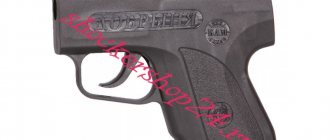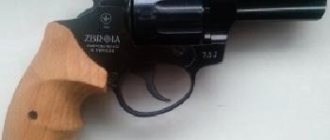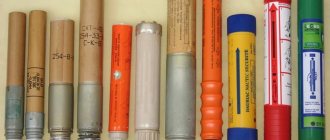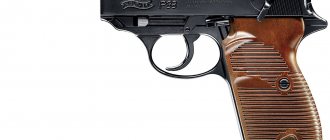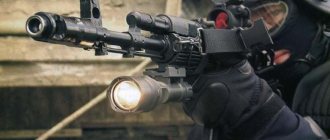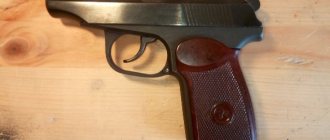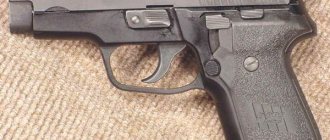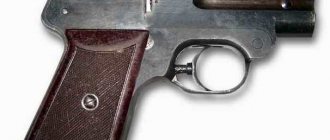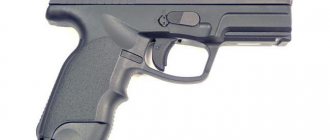Signal and lighting pistols (“Rocket launchers”)
Of the special, non-combat pistols, we mention signal and lighting pistols, often called “rocket launchers” and which have found wide application not only in the military, but also in the civilian field. Of course, the rocket or reactive principle is not used in them. It’s just that before the adoption of such pistols, the army widely used signal and illuminating powder flares. In memory of them, the signal and shining “stars” fired from pistols in Russia continued to be called “rockets,” and the pistols themselves were called “rocket launchers.” In fact, they are not weapons, but special short-range pyrotechnics. The special nature of these means allows us to limit ourselves to a brief consideration of them.
Signal and lighting 26-mm pistols used in the USSR and Russia over the years: signal Degtyarev model 1930 (SPD), lighting Shpagina model 1942 (OPSh), signal signal model 1981 (SP-81 ), signal Shpagina model 1944 (SPSh-44)
Interest in signal pistols arose in the Russian army and navy after the Russo-Japanese War. The fleet, in particular, was interested in the English signal pistol and signal gun of the Baer system of 34-35 mm caliber. However, in 1908, Captain 2nd Rank Zhukov proposed a simpler and cheaper “missile signaling” system based on a signal pistol, which became widespread on ships of the Russian fleet.
In 1910, the 27-mm signal pistol of Colonel S.A. was adopted. Zybin, in the design of which elements of a single-shot hunting rifle were used. This is not accidental - Zybin served as the head of the ITOZ hunting workshop. However, the similarity of signal pistols in caliber (their common caliber is 26 mm is nothing more than the 4th hunting) and design with “turning point” hunting rifles remained later, both in domestic and foreign designs.
G.S. Shpagin (1897–1952)
The First World War urgently required pyrotechnic signaling and lighting equipment, including special pistols. They were necessary both for sending light signals (commands, mutual recognition signals, interaction signals) and for illuminating the area, which allowed troops to observe the front line of defense and fire at the enemy at night. Signal pistols were especially needed by infantry and artillery. The shortage of pistols was covered by various improvisations, such as remaking hunting rifles, as well as purchases abroad. Of the various means used in the Russian army, lighting pistols and English-style cartridges were considered the most successful. The ships of the Baltic Fleet and aviation had signal pistols of the Veri system. The production of 26-mm signal pistols was then set up at the Imperial Peter the Great Tula Arms Factory, and cartridges for them - at the Troitsky Equipment Factory. Production at the Troitsk plant during this period was headed by V.I. Rdultovsky - a signal pistol of his design also found distribution among the troops.
War experience showed that signaling and lighting equipment, providing small units with the ability to give signals and illuminate the area, play an important role not only in the positional conditions of “trench” warfare, but also in maneuver operations. For service with the Red Army in the 1930s. A 26-mm signal pistol from the Izhevsk Arms Plant (pistol model 1927) and a Degtyarev signal pistol model. 1930 (SPD), which remained the main ones until the middle of the Great Patriotic War. Already during the war, a new system of signal and lighting pistols was developed by Georgy Semenovich Shpagin (1897-1952), by that time already a well-known gunsmith designer. In 1943, the 26-mm OPSh (OPSh-1) illumination pistol entered service, production of which began in besieged Leningrad. In the same year, SPSh-2 (“Shpagin’s second signal pistol”) was adopted, which became best known under the designation SPSh-42. During the war, signal pistols were produced, in particular, by Izhevsk plant No. 622.
Diagram of the design of a signal pistol from the copyright certificate for an invention received by G.S. Shpagin in 1944
The design of the SPS is largely borrowed from the German Walther signal pistol of the 1928 model, but is made simpler, using cold stamping and spot welding, with the expectation of minimal production costs using domestic equipment and the use of domestic signal and lighting cartridges.
The caliber of the smooth, hinged barrel is 26 mm. The impact mechanism is with an open hammer and a cylindrical helical mainspring. The hammer is cocked manually before firing. The open trigger allows you to shoot with mittens. SPS is used for signaling, orientation, illumination of the area, and communication with aviation. The pistol is very easy to use. To load, you need to press the barrel latch forward, tilt the barrel down, insert a signal cartridge into the chamber and return the barrel to its place. After the shot, the trigger is set to the safety cock (“release” of the trigger). When the barrel is unlocked after firing, the extractor pushes the spent cartridge out of the barrel so much that it is convenient to remove it by hand, which speeds up reloading. The pistol does not have any sighting devices. A fabric holster on the shoulder strap is used to carry the pistol and ammunition.
General view, parts and assemblies of the 26-mm signal pistol SPSh model 1944: 1 - barrel, 3 - butt plate, 4 - trigger axis, 5 - trigger, 6 - pusher, 7 and 16 - handle cheeks, 8 - connecting screw cheeks, 9 - mainspring support bar, 10 - mainspring, 15 - nut for connecting screw, 11 - sling swivel, 12 - frame, 13 - tubular axis, 14 - barrel latch, 17 - barrel and trigger latch spring, 18 — trigger, 19 — trigger axis, 20 — extractor groove and stop, 21 — extractor, 22 — extractor front protrusion, 23 — cutout for the barrel bushing (axis)
In 1944, based on the SPS, Shpagin developed an aviation 40-mm “rocket launcher” for sending mutual identification signals - this is what the “friend or foe” system looked like then. At the same time, a slightly modernized SPSh-44 pistol was created, which went into service with the troops in 1945.
26mm signal and illumination cartridges in the 1930s. were developed among other signaling and lighting equipment at explosives factories - No. 5 (Okhtensky) and No. 11 (Troitsky). By the beginning of the Great Patriotic War, there were several types of 26-mm signal cartridges: daytime smoke and night-time luminous. The 26-mm luminous night-action cartridge consists of a paper (folder) cartridge case with a metal tray, an igniter primer, an expelling powder charge of black powder and a signal “star” (torch) in one of four colors. When fired, the expelling charge ejects the sprocket, the ignition composition of the star is ignited by the gases of the expelling charge. After the ignition composition burns out (still on the rise), the star lights up and produces a flame of a certain color. The star of the luminous cartridge is visible for 6.5-7 seconds at a distance of up to 5-7 km during the day and up to 10 km at night. It is possible to fire a cartridge containing 2-6 stars of the same or different colored lights (combined). The 26-mm daytime signal cartridge, instead of a luminous star, is equipped with a smoke composition in a shell, also often called a “star”. Smoke cartridges create a cloud at a height of 65-70 m, visible at a distance of up to 5 km for 10 seconds in windy weather and up to 30 seconds in calm weather.
The 26-mm illumination cartridge differed from the signal cartridge in the larger mass of the star, which, with a flight range of up to 120 m, provided illumination of the area within a radius of up to 100 m for 7 seconds. In 1942-1943 parachute cartridges developed at NII-6 of the People's Commissariat of Ammunition were introduced - reducing the size of the star also reduced the radius of illumination, but the area was illuminated for 15-20 seconds or more evenly, which allowed units to conduct targeted fire at night at a distance of up to 300 m. At the same time, red daytime cartridges appeared , yellow, blue smoke. In 1944, parachute smoke and signal whistling-light cartridges were introduced. In addition, the technology for manufacturing pyrotechnic compositions was forced to change - for example, in equipping a 26-mm red fire cartridge, due to a lack of strontium nitrate, the more accessible mineral celestine was used; in green fire compositions, the scarce hexachlorobenzene was replaced with available polyvinyl chloride resin; in lighting compositions, instead of synthetic resins natural asphalt was used. Such measures made it possible not to reduce and even expand the production of signal and lighting cartridges. As you can see, despite the presence of wired and radio communications, the importance of signal pistols remained great. They were used in almost all branches of the military. It is no coincidence that 26-mm cartridges turned out to be perhaps the most expendable of signal and lighting ammunition.
26-mm cartridges for lighting and signal pistols: a - lighting, b - parachute lighting, c - night-signal with five stars, d - day-signal, d - imitation
The imitation 26-mm cartridge that appeared before the war was also curious - giving a flash, a cloud of smoke and a sharp sound, it made it possible to simulate the air burst of a shrapnel shell during exercises.
Repeatedly attempts were made to give signal pistols “combat” properties. Thus, in the fall of 1941, a 26-mm “sabotage” cartridge with an incendiary grenade was created for special groups of the NKVD and partisan detachments. Already in the 1970s. For units of the Ministry of Internal Affairs, a 26-mm gas grenade “Cheryomukha-4” was created, equipped with the irritant formulation HAF (CN): the maximum firing range of the grenade is 165 m, but more or less accurate shooting is possible up to 25 m.
Bag for signal pistol SPS
26-mm signal pistol SP-81 and design diagram of the signal cartridge
The SPS pistol turned out to be a simple and successful design, remained in service to this day both in Russia and in a number of other countries, was widely used in the civilian sphere, and was a common weapon not only for geological parties or rescuers, but also for sports and tourist camps. But the RF Law “On Weapons”, as amended in 1997, identified a special group of “signal weapons”, and the acquisition of a “flare gun” suddenly required obtaining a license issued by the internal affairs bodies, despite the fact that much more dangerous holiday pyrotechnics can be freely purchased at kiosks .
To replace the SPSh, the SP-81 signal pistol chambered for 26×79 cartridges was adopted. The production of SP-81 was carried out by the Kovrov Mechanical Plant. A characteristic feature of the SP-81 is the shortening of the barrel, which made it possible to reduce the size and weight of the pistol - the pistol is 175 mm long and weighs 0.6 kg without a cartridge. The height of the signal when firing from the SP-81 reaches 120 m, the flight range of the star is 90 m. The most used cartridges are single-star illumination (SPO) and signal red (SPK) and green (SPZ) lights.
26 mm signal pistols SP-81
Tactical and technical characteristics of SPS
- Caliber - 26 mm
- Weight of weapon without cartridge - 0.9 kg
- Weight of weapon with cartridge - 0.96-0.975 kg
- Weapon length - 220 mm
- Barrel length - 150 mm
Share link
New on the signal weapons market - the TAURUS-S revolver, caliber 5.6/16, with a Zhevelo capsule!
The RossImportOruzhie company is expanding its range of signal weapons, opening up a completely new segment for the buyer - signal revolvers and pistols, made identical to popular models of foreign short-barreled weapons.
Let's show the cards right away: the new TAURUS-S signal revolver has never been a firearm - it is made directly as a signal revolver. However, the external dimensions, weight and, especially, the material of manufacture are similar to real TAURUS revolvers on the smallest frame.
The new signal TAURUS-S is made for the popular model 905, which uses 9x19 Luger pistol cartridges for firing.
5 cartridges are combined into a star clip and loaded into the drum at the same time. To preserve the authenticity of the model, special cartridges have been developed for the signal TAURUS that imitate the bottom of a pistol cartridge.
A Zhevelo type capsule is installed in each cartridge. The use of the Zhevelo capsule in combination with cartridges allows you to purchase this signal weapon without a license, since its caliber is less than 6 mm. At the same time, thanks to the cartridges, the owner is not deprived of the opportunity to equip the signal revolver in the same way as its combat counterpart.
To meet forensic requirements, the barrel, frame and drum of the revolver are one piece. To prevent a shot from a solid object loaded from the muzzle side, a blind pin is installed at some distance from it. Apart from the grip cheeks, the TAURUS-S signal revolver is entirely made of steel.
The trigger mechanism of the revolver is double action, which allows you to fire a shot both with a cocked hammer and self-cocking. Loading is carried out using sprocket clips and cartridges installed in the seats of each sprocket.
Equipped with five cartridges, the sprocket clip is inserted and removed from the drum when the latter is tilted to the side. The TAURUS signal revolver is structurally a modern revolver, which embodies all the latest achievements of the arms industry both in design and in the mechanism.
Thanks to this and, in particular, to the all-steel construction, the new TAURUS, with periodic maintenance, is an almost eternal signal weapon, capable of pleasing its owner with impeccable operation and equally impeccable similarity to its military counterpart.
ATTENTION! A limited edition of TAURUS-S is on sale! Hurry up to order now!

